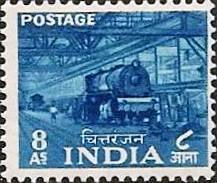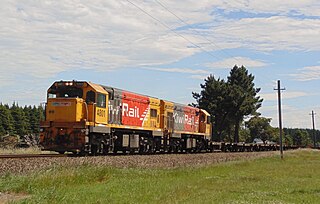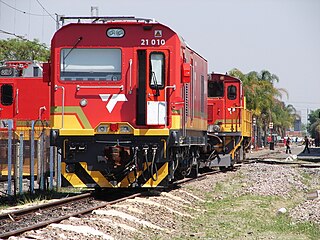
A locomotive is a rail transport vehicle that provides the motive power for a train. If a locomotive is capable of carrying a payload, it is usually rather referred to as a multiple unit, motor coach, railcar or power car; the use of these self-propelled vehicles is increasingly common for passenger trains, but rare for freight trains.

A third rail, also known as a live rail, electric rail or conductor rail, is a method of providing electric power to a railway locomotive or train, through a semi-continuous rigid conductor placed alongside or between the rails of a railway track. It is used typically in a mass transit or rapid transit system, which has alignments in its own corridors, fully or almost fully segregated from the outside environment. Third-rail systems are usually supplied from direct current electricity.

Japan Freight Railway Company, or JR Freight, is one of the seven constituent companies of Japan Railways Group. It provides transportation of cargo nationwide throughout Japan. Its headquarters are in Shibuya, Tokyo near Shinjuku Station.

An electric locomotive is a locomotive powered by electricity from overhead lines, a third rail or on-board energy storage such as a battery or a supercapacitor. Locomotives with on-board fuelled prime movers, such as diesel engines or gas turbines, are classed as diesel–electric or gas turbine–electric and not as electric locomotives, because the electric generator/motor combination serves only as a power transmission system.

Railway electrification is the use of electric power for the propulsion of rail transport. Electric railways use either electric locomotives, electric multiple units or both. Electricity is typically generated in large and relatively efficient generating stations, transmitted to the railway network and distributed to the trains. Some electric railways have their own dedicated generating stations and transmission lines, but most purchase power from an electric utility. The railway usually provides its own distribution lines, switches, and transformers.

An electro-diesel locomotive is a type of locomotive that can be powered either from an electricity supply or by using the onboard diesel engine. For the most part, these locomotives are built to serve regional, niche markets with a very specific purpose.

The British Rail Class 20, otherwise known as an English Electric Type 1, is a class of diesel-electric locomotive. In total, 228 locomotives in the class were built by English Electric between 1957 and 1968, the large number being in part because of the failure of other early designs in the same power range to provide reliable locomotives.

Chittaranjan Locomotive Works (CLW) is an electric locomotive manufacturer based in India. The works are located at Chittaranjan in the Asansol Sadar subdivision of West Bengal, with an ancillary unit in Dankuni. The main unit is 32 km from Asansol’s City Bus Terminus and 237 km from Kolkata. CLW has stores and offices in Kolkata, as well as inspection cells in New Delhi, Mumbai, Kolkata, and Bangalore. It is the largest locomotive manufacturer unit in the world, producing 431 locomotives in 2019–20.

Hekurudha Shqiptare or HSH(Albanian Railways) is the state-owned operator of the Albanian railway system and became a private company in 2005. The system's main passenger terminal was Durrës railway station in the port city of Durrës.

The New Zealand DC class locomotive is a type of diesel-electric mainline locomotive on the New Zealand rail network, operated by KiwiRail on freight trains, and formerly on long-distance passenger trains. The class was rebuilt from the DA class in the late 1970s and early 1980s, mainly in Australia. After the DA class, they were the most numerous class of diesel locomotive on New Zealand's railway network and remained numerically dominant until the mid-2010s when withdrawals began.
Railway electric traction describes the various types of locomotive and multiple units that are used on electrification systems around the world.

The EMD G16 is a diesel locomotive built by General Motors in the US and under licence by Clyde Engineering in Australia and MACOSA in Spain. It has been used in Australia, Brazil, Egyptian Railways, Hong Kong, Israel Railways, Mexico, Spain, Yugoslav Railways and on the successor Croatian Railways, Slovenian Railways, Serbian Railways, Macedonian Railways, Republika Srpska Railways, Kosovo Railways and Railways of the Federation of Bosnia and Herzegovina.

Trainkos is a private railway company based in Kosovo that also serves as the national rail carrier of the country. Established in 2011 alongside Infrakos, the two companies are the successors of Kosovo Railways, a public company that was split up and privatized. Trainkos offers rail service for both passengers and freight.

The GT46C-ACe is a model of Australian diesel-electric locomotive designed and built between 2007–present by Downer Rail at its Cardiff Locomotive Workshops using Electro-Motive Diesel components until 2014, with later units built in Muncie, Indiana.

The Transnet Freight Rail Class 19E of 2009 is a South African electric locomotive.

A multi-system locomotive, also known as a multi-system electric locomotive, multi-system electric multiple unit, or multi-system train, is an electric locomotive which can operate using more than one railway electrification system. Multi-system trains provide continuous journeys over routes which are electrified using more than one system.

The Kosovo Train for Life carried aid from the United Kingdom to Pristina, Kosovo, in September 1999 in connection with the United Nations Kosovo Force (KFOR) peacekeeping efforts after the Kosovo War.

The Transnet Freight Rail Class 21E of 2014 is a South African electric locomotive.

















